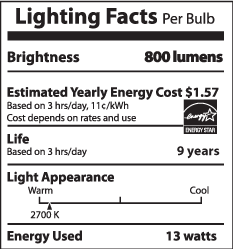Buying Bulbs Based on Lumens
 Since the first screw base and socket bulbs were made in 1882, lamps have been purchased based on wattage used. Fast-forward 130 years and there is a new metric for light bulbs — “lumens.” Lumens are a measurement of the amount of light produced. This makes a lot of sense since we buy things based on how much of it we get. When buying milk, we buy it by the volume (gallons). So, why should light be any different?
Since the first screw base and socket bulbs were made in 1882, lamps have been purchased based on wattage used. Fast-forward 130 years and there is a new metric for light bulbs — “lumens.” Lumens are a measurement of the amount of light produced. This makes a lot of sense since we buy things based on how much of it we get. When buying milk, we buy it by the volume (gallons). So, why should light be any different?In addition to the new labels telling us how bright light bulbs are, there is some other important information, such as:
*Estimated yearly energy cost
*Lifespan of the bulb
*Light appearance (warm to cool)
*Energy used
So, the next challenge is to learn what lumens to use around the house. Here is a rule of thumb:
*To replace a 100-watt incandescent bulb, look for a bulb that gives you about 1600 lumens. If you want something dimmer, go for fewer lumens; if you prefer brighter light, look for more lumens.
*Replace a 75W bulb with an energy-saving bulb that gives you about 1100 lumens.
*Replace a 60W bulb with an energy-saving bulb that gives you about 800 lumens.
*Replace a 40W bulb with an energy-saving bulb that gives you about 450 lumens.
You can return to the main Market News page, or press the Back button on your browser.

